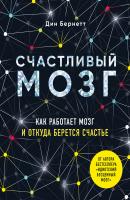Счастливый мозг. Как работает мозг и откуда берется счастье. Дин Бернетт
Чтение книги онлайн.

Читать онлайн книгу Счастливый мозг. Как работает мозг и откуда берется счастье - Дин Бернетт страница 34
Название: Счастливый мозг. Как работает мозг и откуда берется счастье
Автор: Дин Бернетт
Издательство: Эксмо
Жанр: Биология
Серия: Просто о мозге
isbn: 978-5-04-095041-6
isbn:
68
Lourenco, S.F., M. R. Longo, and T. Pathman, Near space and its relation to claustrophobic fear. Cognition, 2011. 119 (3): p. 448–453.
69
Kennedy, D.P., et al., Personal space regulation by the human amygdala. Nature neuroscience, 2009. 12 (10): p. 1226–1227.
70
Evans, G.W. and R. E. Wener, Crowding and personal space invasion on the train: Please don’t make me sit in the middle. Journal of Environmental Psychology, 2007. 27 (1): p. 90–94.
71
Schwartz, B., The social psychology of privacy. American Journal of Sociology, 1968: p. 741–752.
72
Berman, M.G., J. Jonides, and S. Kaplan, The Cognitive Benefits of Interacting With Nature. Psychological Science, 2008. 19 (12): p. 1207–1212.
73
Ulrich, R., View through a window may influence recovery. Science, 1984. 224 (4647): p. 224–225.
74
Dobbs, D., The Green Space Cure: The Psychological Value of Biodiversity. 2007, November.
75
‘Tiny house movement’ – Wikipedia, 2017. Available from https://en.wikipedia.org/wiki/Tiny_house_movement.
76
Bouchard, T.J., Genes, environment, and personality. SCIENCE-NEW YORK THEN WASHINGTON-, 1994: p. 1700–1700.
77
Oishi, S. and U. Schimmack, Residential mobility, well-being, and mortality. Journal of personality and social psychology, 2010. 98 (6): p. 980.
78
Jang, Y. and D. E. Huber, Context retrieval and context change in free recall: recalling from long-term memory drives list isolation. Journal of Experimental Psychology: Learning, Memory, and Cognition, 2008. 34 (1): p. 112.
79
Rubinstein, R.L., The home environments of older people: A description of the psychosocial processes linking person to place. Journal of Gerontology, 1989. 44 (2): p. S45-S53.
80
Winograd, E. and W. A. Killinger, Relating age at encoding in early childhood to adult recall: Development of flashbulb memories. Journal of Experimental Psychology: General, 1983. 112 (3): p. 413.
81
Lollar, K., The liminal experience: loss of extended self after the fire. Qualitative Inquiry, 2009.
82
Jones, R.T. and D. P. Ribbe, Child, adolescent, and adult victims of residential fire: Psychosocial consequences. Behavior Modification, 1991. 15 (4): p. 560–580.
83
Kim, K. and M. K. Johnson, Extended self: medial prefrontal activity during transient association of self and objects. Social cognitive and affective neuroscience, 2010: p. nsq096.
84
Proshansky, H.M., A. K. Fabian, and R. Kaminoff, Place-identity: Physical world socialization of the self. Journal of environmental psychology, 1983. 3 (1): p. 57–83.
85
Anton, C.E. and C. Lawrence, Home is where the heart is: The effect of place of residence on place attachment and community participation. Journal of Environmental Psychology, 2014. 40: p. 451–461.
86
University of Bologna – Wikipedia. 2017; Available from: https://en.wikipedia.org/wiki/University_of_Bologna.
87
Wilson, M. Stunning Documentary Looks At Life Inside A Marble Mine. 2014 2014–11–14; Available from: https://www.fastcodesign.com/3038512/stunning-documentary-looks-at-life-inside-a-marble-mine.
88
ReviseSociology, What Percentage of Your Life Will You Spend at Work? in ReviseSociology. 2016, @realsociology.
89
Statistics – Work related stress, anxiety and depression statistics in Great Britain (GB). 2017; Available from: http://www.hse.gov.uk/statistics/causdis/stress/.
90
Statistics, B.o.L. Number of Jobs, Labor Market Experience, and Earnings Growth: Results From A Longitudinal Survey. 2017; Available from: https://www.bls.gov/news.release/nlsoy.toc.htm.
91
Erickson, K.I., C. H. Hillman, and A. F. Kramer, Physical activity, brain, and cognition. Current Opinion in Behavioral Sciences, 2015. 4 (Supplement C): p. 27–32.
92
Swaminathan, N., Why Does the Brain Need So Much Power? Scientific American, 2008. 29 (04): p. 2998.
93
Sleiman, S.F., et al., Exercise promotes the expression of brain derived neurotrophic factor (BDNF) through the action of the ketone body β-hydroxybutyrate. Elife, 2016. 5: p. e15092.
94
Godman, H., Regular exercise changes the brain to improve memory, thinking skills. Harv Health Lett, 2014.
95
White, L.J. and V. Castellano, Exercise and Brain Health – Implications for Multiple Sclerosis. Sports medicine, 2008. 38 (2): p. 91–100.
96
Kohl Iii, H.W. and H. D. Cook, Physical Activity, Fitness, and Physical Education: Effects on Academic Performance. 2013.
97
СКАЧАТЬ